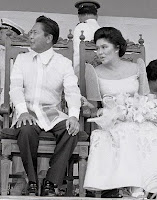Change from within: how science and celebrity can effect it
 It has often been highlighted that to get on a sustainable course towards prosperity, Filipinos need not a change of men but a change in men. It is a social transformation that needs to come from within. An article in Scientific American provides insight on how lessons learned from the success of some past initiatives that aimed to transform thinking in people and shape their regard for what were once deeply-ingrained beliefs and mindsets could be re-applied today.
It has often been highlighted that to get on a sustainable course towards prosperity, Filipinos need not a change of men but a change in men. It is a social transformation that needs to come from within. An article in Scientific American provides insight on how lessons learned from the success of some past initiatives that aimed to transform thinking in people and shape their regard for what were once deeply-ingrained beliefs and mindsets could be re-applied today.In "Behavior Frontiers: Can Social Science Combat Climate Change?", researchers are looking to "remove some of the guesswork about how individuals will use energy in 2050 by looking at past campaigns to induce personal change and their effectiveness".
By studying past instances of social transformation, scientists at Lawrence Berkeley National Laboratory (LBNL) hope to predict future change in response to global warming as part of California’s Carbon Challenge—a study commissioned by the California Energy Commission to help the state cut greenhouse gas emissions by 80 percent below 1990 levels.
Lessons from how smoking was successfully turned from cool to uncool over the last several decades, and how a campaign to encourage the use of seat belts succeeded at strengthening laws to enforce their use might, in theory, be applicable to inducing change in critical human activities today where opportunities to reduce energy consumption abound.
For example, tobacco smoking has been in a steady decline since the 1960s with all sorts of factors driving this trend—improved science and epidemiology, education through labeling and advertising campaigns, and greater public awareness of risks—all of which could be applied to behaviors that contribute to climate change. "Watershed events and labeling can play important roles in transforming change. The 1964 Surgeon General report is an example [of a watershed event] and subsequent labeling for cigarettes was a big factor," says energy researcher Max Wei of LBNL, adding that he imagines far more carbon or environmental labeling to inform the public.
By identifying the hurdles, policies and incentives used to, say, dissuade smokers from lighting up, the LBNL team says they can better pinpoint corresponding elements related to persuading individuals to alter their energy use.
Thus for the purposes of reducing energy consumption and, consequently, Americans' carbon footprint, things like eating less meat, switching off unused lights, setting the thermostat to warmer temperatures in summer and lower temperatures in winter, among others, represent the next frontier of behavioural change campaigns.
Energy use coming from a runaway First World lifestyle happens to be the most relevant macro change imperative for Americans. For Filipinos the macro imperative is more basic -- alleviating poverty and invigorating the economy.
For Filipinos, perhaps, a similar approach can be applied to developing programs and campaigns to change readily-apparent dysfunctional behaviours that contribute to the chronic poverty that our country is renowned for. Low savings rates, weak propensity to invest, consumerism, runaway reproduction, fiesta mentality, lack of imagination, atrophied sense of personal accountability, indifference to rules, and an inability to honour commitments among others collectively form a complex of character traits that predispose Filipinos to muddle along in that familiar mediocrity we have collectively become comfy with.
It is interesting to note that there is no one specific political solution that will address the roadblocks to prosperity presented by our dysfunctional culture. The solution lies in a sustained campaign to push a people who are driven primarily by a sense of hiya (shame), and not by any higher or nobler collective purpose. By progressively stigmatising these Filipino mindsets and character traits change can be effected from within. It is up to the influential among us -- celebrities and opinion shapers -- to effect this campaign by sending out the right messages and serving as role models to the people who take their cue from them.




What other approaches can be used to dissuade Da Pinoy from continuing on with the dysfunctional behaviors you stated above?
ReplyDeleteThe most basic approach I know is that to juxtapose the pros of adopting a "better" behavior and cons of retaining the "dysfunctional" one. Although it would have to be more "emo" to suit the audience at hand.
Then again, why would Da Pinoy change that behavior when other, more successful cultures have the same or similar behavior? The "others have X and they are better-off so why would I change in using X?" argument.
[I really hate that kind of argument]
Indeed, there needs to be an emotional hook. That's how brand marketing and advertising work. You don't sell an iPod by spelling out technical details about it to prove it is better than another MP3 player. You market it by making it come across as a trendy personal statement that speaks of one's taste and lifestyle.
ReplyDeleteIf ever some mythical marketing team manages to craft a perfect attack on changing Da Pinoy behavior for the better, It should leave room for self-reflection and improvement. Giving people intricate instructions on what to do tend to make them dependent on the instruction given and not think for themselves.
ReplyDeleteAny ideas on what sort of emotional hook would complement the intended outcome? It must be familiar though or it may risk people to strongly avoid it entirely
Through an article by ChinoV I linked over to a site by the World Bank listing all the "percentages" of foreign investment allowed by different countries.
ReplyDeleteI was quite surprised to find that many East Asian countries, especially the most developed ones (and fastest-developing ones), still refuse to allow a majority foreign presence in terms of investing in their media.
http://iab.worldbank.org/Data/Explore%20Topics/Investing-across-sectors/Media
I'm not sure if it's the government or constituencies feeding the media or vice versa, but clearly they seem to be doing something with their 51/49 at the most that has helped them develop so fast as of late.
So if perhaps we can change what the people want to see to something more than petty showbiz, then perhaps that'll work its way up to the media, who can then solidify such influences.
I know it sounds quite insular, but these are Filipinos (however much the Filipino "mentality" deserves its criticisms) thinking that maybe these solutions from other countries are right.
Goes back to the bigger question: Have Filipinos earned the right to be "free"?
ReplyDeleteThe greed of the sheeple, is way of the charts. The elite has feed us for a century now, and if this overconfidence becomes uncontrollable then there will come a time when the owner will kill the cats because the "earth" cannot sustain the how to feed the cats.
ReplyDeleteThe code that the animal must die if he refuse to hunt for its own food will suffice this madness the human society has become. Its not about pinoys, its all about the human society!!! The sheeps that is really predictable, will be on a fat mans plate latter on.
Whats the problem nowadays is the people conform. They are bunch of carbon copy of everyone else. What is not in front of their faces, on a certain time is what they NEED!!! It is a fact, that humans are delusional and blinded by greed. I repeat this earth will not heal unless, the sheeps are not yet dead. And YES, Death will come to them like the thief in the night!!!